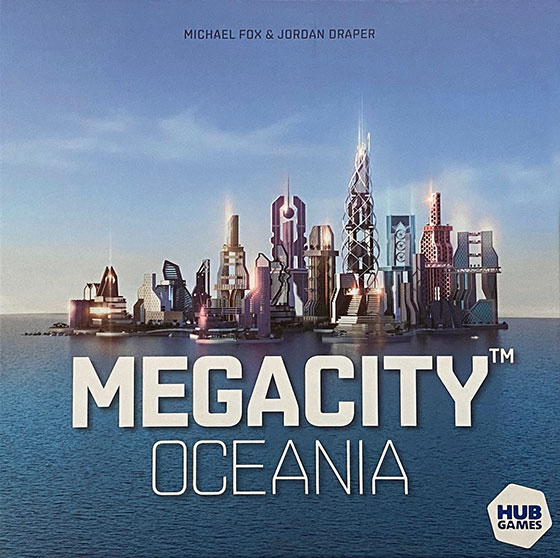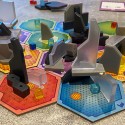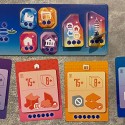‘MegaCity: Oceania’ Board Game Review

As a rule, I really struggle to enjoy dexterity based games – and this tends to be something I find splits my friends right down the middle. Some are capable of the kind of deft movements that you’d associate with Legolas and his elven brethren, whilst me and the other half are more like Gimli in our movements. When it comes to MegaCity: Oceania, however, there is hope. This is a dexterity games, there’s no doubt about it, but it’s a little calmer and a little smarter than the average game of Jenga.
The premise for MegaCity: Oceania is simple, and two to four players will compete to obtain prestige points whilst collectively constructing a floating city. To do this, each player will take turns to draw from a market of building tiles or contract cards, or they may draw building pieces from a bag (either taking several blindly, or by searching for a specific single piece.) The best way to score prestige points is to complete those contracts, which will require the players to assemble the correct number and type of building pieces onto the right sort of tile.
In the event that a player has managed to construct a building that meets the requirements of their contract card – in this case, it must contain eight building pieces, it must include an arch, and it must be 60mm high according to the included rulers. All construction is done in between turns, meaning that downtime is kept to a minimum. Assuming that the player has their constructed building ready and sitting on the appropriate tile, it can be added to the city on their next turn.
If the player chooses to do this, they will not be able to take the normal actions of collecting a tile, contract or building materials, and will instead carefully slide their tile towards the city, complete with the building. If the whole thing should topple over and fall down, then it’s no great problem – the player simply brings back their components and essentially loses the turn entirely. On their next turn, they can try and place the same building again, go back to the drawing board, or take a normal turn.
Aside from the standard “draw” actions (of which a player can take any two on each turn) or the construct action which I’ve just explained, players can also occasionally perform special actions involving unique constructions. These include placing a park tile or a monument, each of which is context specific depending on the circumstances. These minor additions provide a good opportunity to score additional points, and whilst they don’t turn MegaCity: Oceania into the next Suburbia, they do add an additional layer of light strategy.
And it’s that mix of undemanding dexterity and light strategy that works so well here, along with a superb look that has to be seen to be believed. Honestly, so few games look as exceptional as MegaCity: Oceania does when it is laid out on the table and the players have added two or three buildings each. The building materials come in three styles – grey, dark grey and clear. These each represent a different building material, but the main thing is, when used to build various different buildings, they create a unique cityscape.
The good news is that whilst you’re building your city, you’re reasonably free to make the dexterity elements of the game as simple or as complex as you like. A player like me is certainly most welcome to pick slightly lower value contracts that require less complex, or lower buildings that are easier to build. However, if someone else is feeling confident and wants to build a little higher, or go for contracts that include fancier features, then they may – but of course that comes with the risk of collapse, and the inherent need to (usually) include more pieces etc.
Over a number of plays at two, three and four players, I found MegaCity: Oceania to be quite even despite a fair mix of experience levels, ages and steady hands at the table. The game always ends after a set number of contracts have been completed, so the game tends to run to about the same length regardless of player count. In all cases, the victory is usually decided within about three to five prestige points between the first and second player – and sometimes, the margin can be that tight across all four.
When all is said and done, MegaCity: Oceania is a pretty unique game that blends strategy and dexterity really nicely. It looks fantastic on the table and it seems to appeal to a wide number of people. I can’t name another game quite like it, and even though I have a few lighter dexterity games in my collection for the benefit of others, this is the only one that I am likely to want to actively play. MegaCity: Oceania is a game that I recommend everyone tries, even if the idea of a dexterity game hasn’t appealed before.




















































